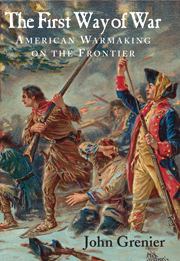Book contents
- Frontmatter
- Contents
- List of Figures and Maps
- Preface
- Acknowledgments
- List of Abbreviations
- Introduction
- 1 The First Way of War's Origins in Colonial America
- 2 The First Way of War in the North American Wars of King George II, 1739–1755
- 3 Continental and British Petite Guerre, circa 1750
- 4 The First Way of War in the Seven Years' War, 1754–1763
- 5 The First Way of War in the Era of the American Revolution
- 6 The First Way of War in the 1790s
- 7 The First Way of War and the Final Conquest of the Transappalachian West
- Epilogue
- Index
5 - The First Way of War in the Era of the American Revolution
Published online by Cambridge University Press: 05 June 2012
- Frontmatter
- Contents
- List of Figures and Maps
- Preface
- Acknowledgments
- List of Abbreviations
- Introduction
- 1 The First Way of War's Origins in Colonial America
- 2 The First Way of War in the North American Wars of King George II, 1739–1755
- 3 Continental and British Petite Guerre, circa 1750
- 4 The First Way of War in the Seven Years' War, 1754–1763
- 5 The First Way of War in the Era of the American Revolution
- 6 The First Way of War in the 1790s
- 7 The First Way of War and the Final Conquest of the Transappalachian West
- Epilogue
- Index
Summary
On Christmas Eve, 1776, George Washington sent a stern warning to the chiefs of Maine's Maliseet–Passamaquoddy nation. “The Cherokees and Southern Tribes,” Washington wrote, “were foolish enough to listen to them [the British] and take the Hatchet Against us; Upon this our Warriors went into their Country, burnt their Houses, destroyed their Corn, and obliged them to sue for peace and give Hostages for their future Good Behavior. Now Brothers never let the King's Wicked Counselors turn your Hearts against Me and my Brethren of the Country.”
Perhaps intending to remind the Indians to stay the course of neutrality should his next morning's raid on Trenton fail and the Revolutionary cause crumble with it, Washington just as likely sought to spread the word of the Americans' might on the frontier. Washington understood the profound importance of the success of the recent American campaign to destroy the Cherokee's Lower and Middle Towns. Whatever would happen at Trenton, Washington could find solace, and the Indians trepidation, in the knowledge that a major portion of the southeastern frontier was open to American settlement.
Yet within the grand narrative of the War of Independence, the raid against the Hessian outpost at Trenton blots out Washington's Christmas Eve message to the Maine Indians. Students of early American military history should not be surprised. The accepted narrative of the War of Independence gives only minor attention to military operations on the frontier.
- Type
- Chapter
- Information
- The First Way of WarAmerican War Making on the Frontier, 1607–1814, pp. 146 - 169Publisher: Cambridge University PressPrint publication year: 2005



